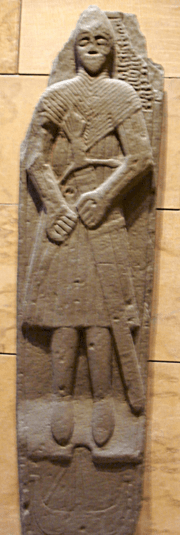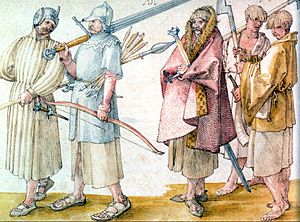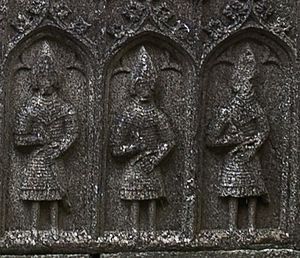Gallowglass facts for kids
The Gallowglass (pronounced Gal-oh-glass) were a special group of strong warriors. They were like hired soldiers, also known as mercenaries. These fighters came from Norse-Gaelic families in Scotland and Ireland.
They were active from the mid-1200s to the late 1500s. The name "Gallowglass" comes from an Irish word meaning "foreign warriors." This is because many of them were Scots whose ancestors were Vikings who had settled in western Scotland. The Irish called them "foreign Gaels."
Some of the first Gallowglass families were the MacSweeneys. They were brought to Ireland by the O'Donnells. Later, other groups like the MacDonnells and MacCabes also became Gallowglass. Powerful Irish leaders hired them.
Gallowglass warriors were important because they were heavily armored and well-trained. They were strong infantry (foot soldiers) who could hold their ground in a fight. Most Irish foot soldiers at the time were not as well protected.
Before gunpowder weapons became common, Gallowglass were a big part of Irish armies. They worked for different Irish clan chiefs who hired them for specific times. An Irish leader might even choose a Gallowglass as a personal bodyguard. Since they were "foreigners," they were less likely to get involved in family arguments within the Irish clans.
Contents
What's in a Name?

The Irish word for Gallowglass is gallóglach. It comes from gall, meaning "foreign," and óglach, meaning "youth" or "hero." So, gallóglach means "foreign young warrior."
When English speakers started using the word, they often used the plural form gallóglaigh (which means "foreign young warriors") as the singular "gallowglass." This is why the English word "gallowglass" sounds a bit like a plural, even when it refers to one warrior!
Where Did They Come From?
The Gallowglass warriors originally came from the western coast of Scotland. This area includes places like Argyll and the Western Isles.
What Were They Like?
A description from the year 1600 said that Gallowglass were "picked and selected men of great and mighty bodies, cruel without compassion." It also said that they were the main strength of a battle. They would "choose rather to die than to yield," meaning they would fight to the death rather than give up.
Gallowglass History

The first time we know of Gallowglass serving in Ireland was in 1259. Aedh Ó Conchobair, the King of Connacht, received 160 Scottish warriors as a gift. They were organized into groups of about 100 men.
Bringing Gallowglass to Ireland was very important. It helped the Irish lords fight back against the Anglo-Normans, who had invaded Ireland in the 1100s. Throughout the Middle Ages, both Irish and Hiberno-Norman (Irish families with Norman roots) lords hired Gallowglass. Even the English leader in Ireland often had a group of them.
In exchange for their fighting service, Gallowglass groups were given land. They also received supplies from the local people.
By 1512, there were 59 groups of Gallowglass warriors across Ireland. They were controlled by Irish nobles. Even though they started as hired soldiers, many settled down. Over time, their ranks included both Scots-Norse people and native Irish men.
In 1569, a powerful Irish leader named Turlough Luineach O'Neill married Lady Agnes Campbell. Her dowry (a gift given with a marriage) included at least 1,200 Gallowglass fighters. With their helpers and friends, this could have meant over 5,000 Gallowglass coming into the area!
Weapons and Armor
Gallowglass warriors were famous for using a huge two-handed axe called a sparth axe. This type of axe came from their Viking ancestors. They also used a large sword called a claymore (claidheamh mór).
For protection, Gallowglass wore a mail shirt (like a chainmail vest) over a padded jacket. They also wore an iron helmet. Each warrior usually had two young helpers. One carried his throwing spears, and the other carried his food and supplies.
The famous writer Shakespeare even mentions Gallowglass in his play Macbeth. However, this is a bit of a mistake in history, as the real Macbeth lived in the 1000s, before Gallowglass were common.
The merciless Macdonwald,
Worthy to be a rebel, for to that
The multiplying villainies of nature
Do swarm upon him, from the Western isles
Of kerns and gallowglasses is supplied
Gallowglass in Battle

In the early 1500s, a report about Irish armies said that the forces in Leinster included 522 horsemen and five groups of Gallowglass. They also had 1,432 kerne (another type of Irish foot soldier). Other parts of Ireland had similar numbers. For example, one leader, Mac Cárthaigh Mór, had 40 horsemen, two groups of Gallowglass, and 2,000 kerne.
In 1517, a report about the armies in Thomond mentioned 750 horsemen, 2,324 kerne, and six "battalions" of Gallowglass. Each Gallowglass group had 60 to 80 foot soldiers wearing armor and carrying spears. Each of these warriors had a helper to carry their armor, and some helpers also carried spears or bows.
Every kerne soldier had a bow, a quiver for arrows, three spears, a sword, and a small knife called a skene. Each two kerne had a young helper to carry their weapons. Horsemen usually had two or three horses, with one carrying their attendant.
The 1500s were a time of increased fighting in Ireland, as the English tried to take more control. Gallowglass fighters were joined by other Irish mercenaries called buanadha and new Scottish mercenaries called "redshanks." During one rebellion, an English leader ordered the killing of 700 captured Gallowglass warriors.
Even with more firearms being used in battles, Gallowglass remained important. They were a key part of Hugh Ó Neill's army in the Nine Years' War (1593-1603). After the Irish lost the Battle of Kinsale in 1601, fewer Gallowglass were hired. However, Scottish Highland mercenaries continued to come to Ireland until the 1640s. They even fought in a big Irish victory at the Battle of Benburb in 1646. Some Gallowglass were recorded attacking a town in County Cork as late as 1645.
Gallowglass warriors also served as mercenaries in armies across Europe. Artists like Dürer sketched them fighting in places like the Netherlands, Switzerland, France, and Sweden.
There's a town in County Donegal, Ireland, called Milford. Its old Irish name, Ballynagalloglagh, means "town of the gallowglasses." A battle between the Irish and English (with Gallowglass help) happened on a hill there, which is how the town got its name.
See also
- Úlfhéðnar
- Fianna
- Gallogly, a surname
Sources
- G. A. Hayes McCoy, Irish Battles, Appletree Press, Belfast, 1990.
- Colm Lennon, Sixteenth Century Ireland: The Incomplete Conquest, Gill & MacMillan, Dublin 1994.
- The Galloglass Project (compiled at TCD, placed online at UCC)


